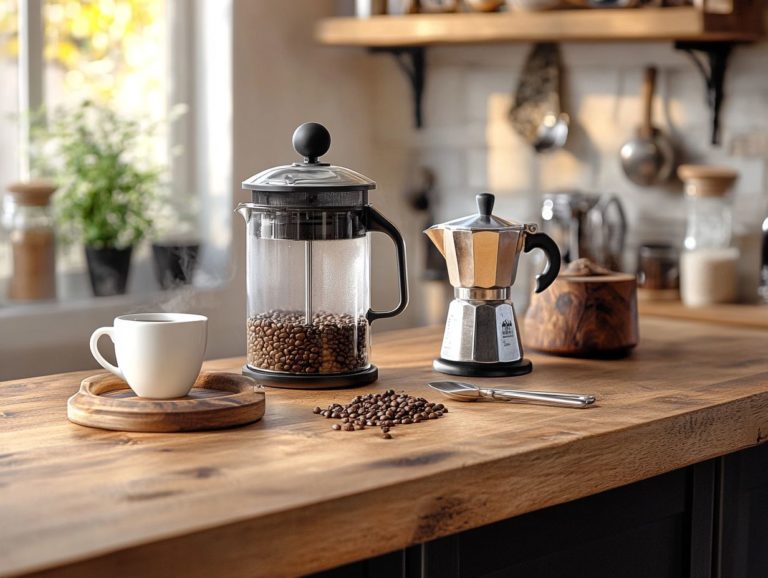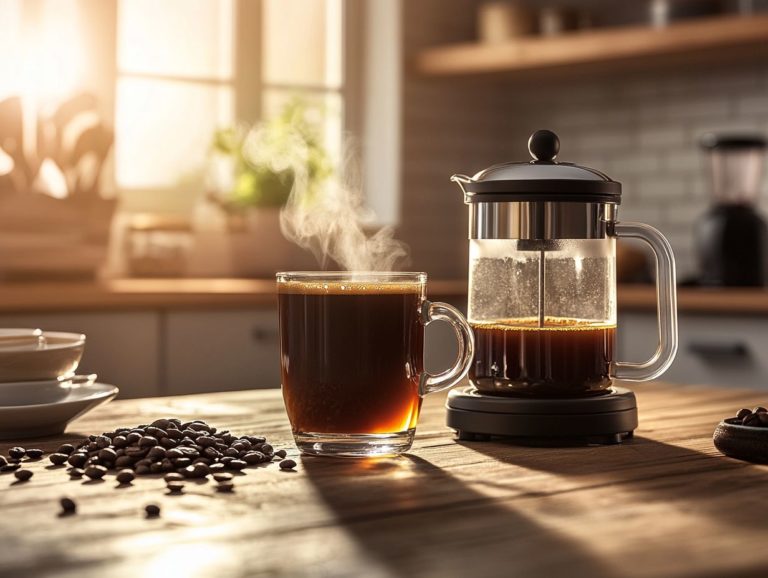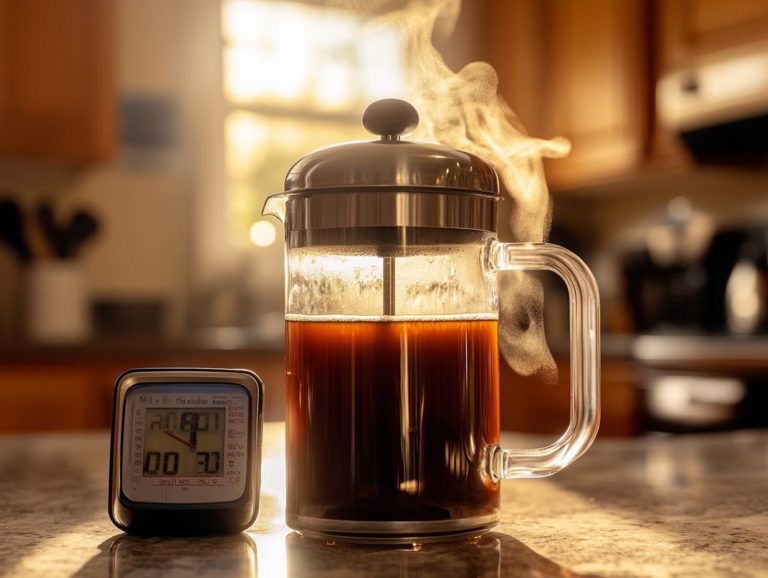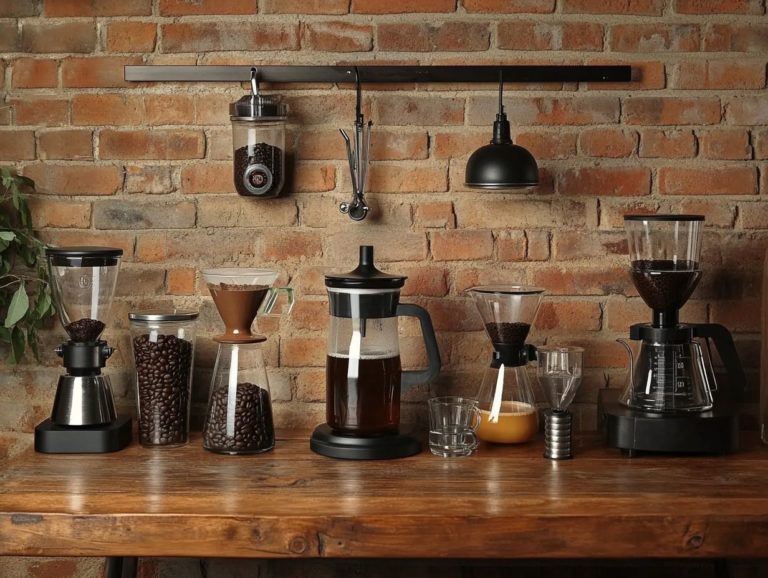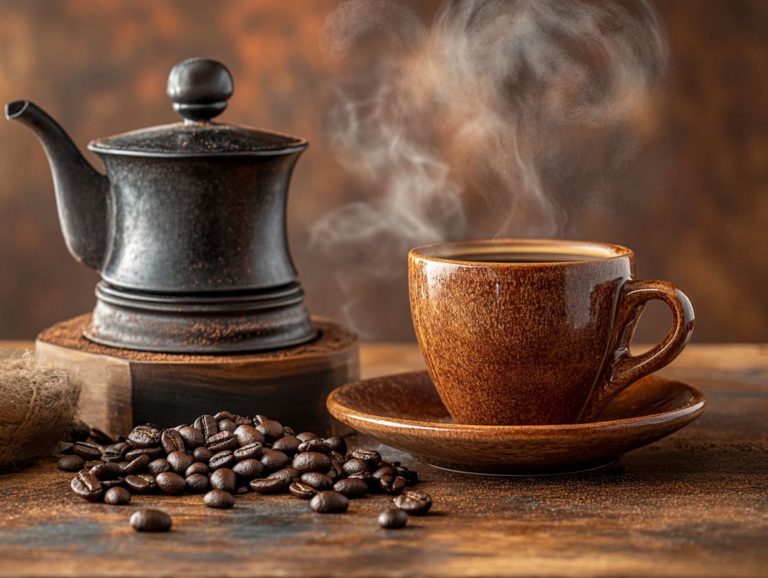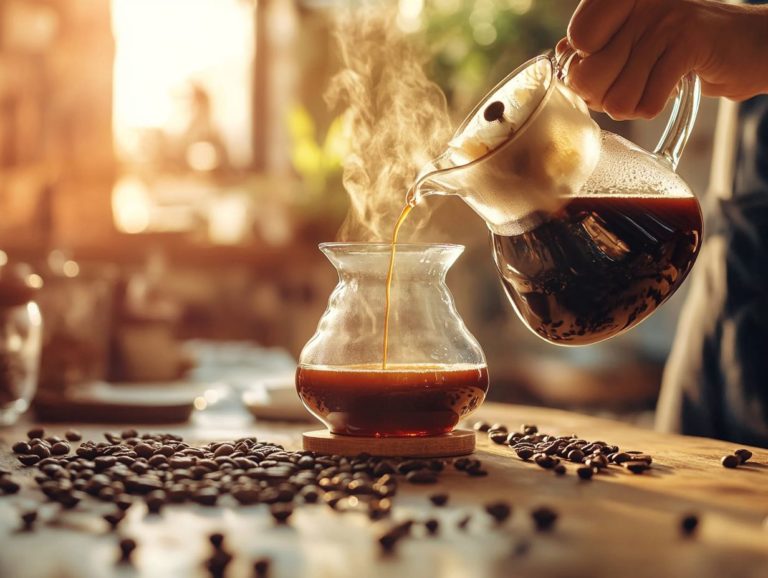How to Brew Coffee with a Stovetop Espresso Maker
Get ready to transform your caffeine ritual! A stovetop espresso maker might just be your secret weapon for crafting rich, aromatic coffee in the comfort of your home. Whether you’re using a classic Moka pot or exploring other espresso alternatives, the right tools can make all the difference.
Delve into the world of stovetop espresso makers understand what they are, how they work, and the diverse types that exist. From the iconic Moka pot to the adaptable French press, uncover the essentials needed to create the perfect brew, including proper coffee ratios and grind sizes.
Follow our comprehensive step-by-step guide to brewing success and gather some valuable tips along the way. From choosing quality coffee beans to mastering your espresso brewing technique, get ready to delight your taste buds like never before!
Contents
- Key Takeaways:
- What Is a Stovetop Espresso Maker?
- How Does a Stovetop Espresso Maker Work?
- What Are the Different Types of Stovetop Espresso Makers?
- Moka Pot
- Percolator
- French Press
- What Do You Need to Brew Coffee with a Stovetop Espresso Maker?
- 1. Coffee Beans
- 2. Grinder
- 3. Stovetop Espresso Maker
- Step-by-Step Guide to Brewing Coffee with a Stovetop Espresso Maker
- Tips for Using a Stovetop Espresso Maker
- Frequently Asked Questions
- How do I use a stovetop espresso maker to brew coffee?
- What kind of coffee should I use in a stovetop espresso maker?
- How much coffee should I use in a stovetop espresso maker?
- Do I need to preheat the stovetop espresso maker before brewing coffee?
- How long does it take to brew coffee with a stovetop espresso maker?
- Can I use a stovetop espresso maker on an electric stove?
Key Takeaways:
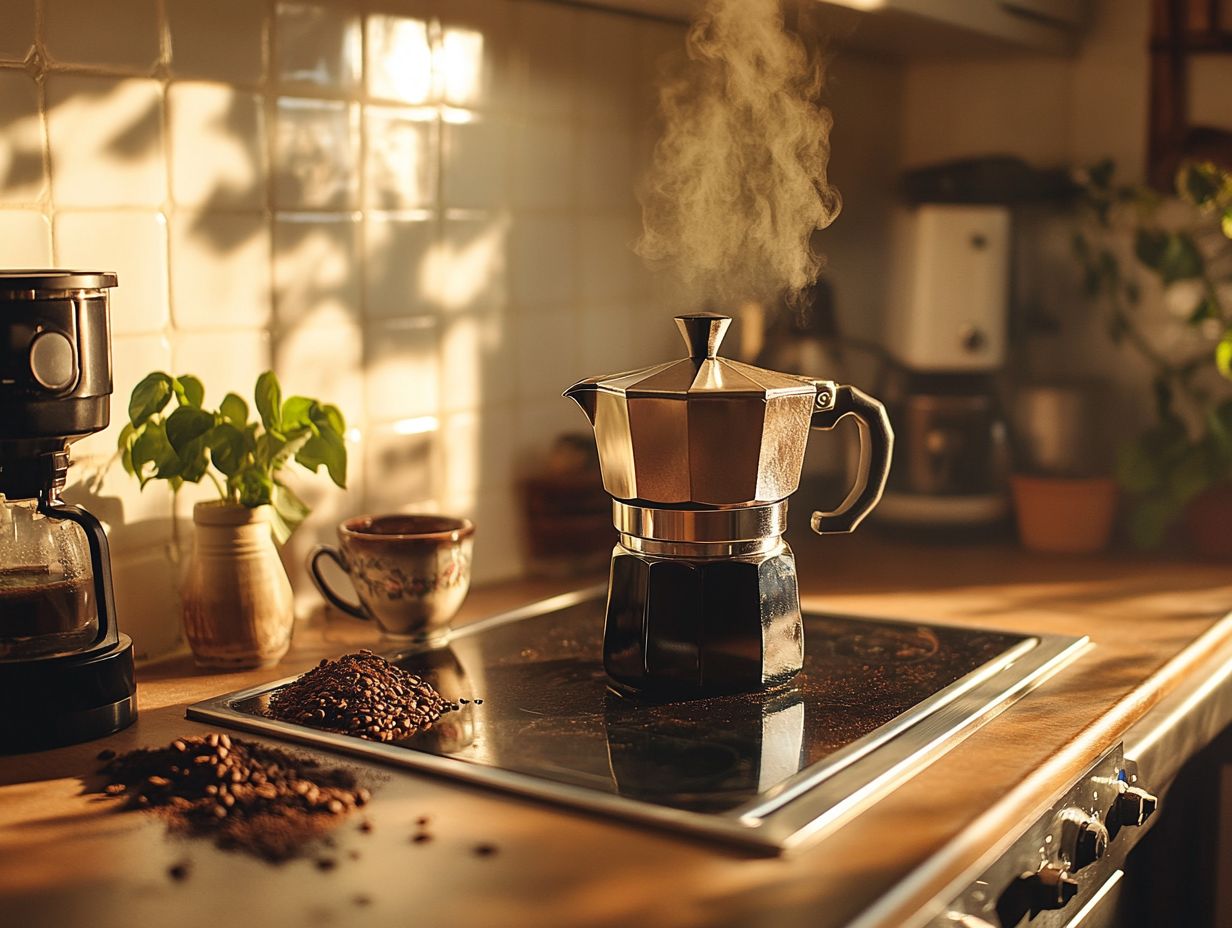
- Learn about the various types of stovetop espresso makers, such as moka pots, percolators, and French presses.
- To brew coffee with a stovetop espresso maker, you will need coffee beans, a grinder, the espresso maker itself, and filtered water.
- Follow a step-by-step guide to brewing coffee, including grinding the beans, adding water and coffee to the maker, and heating and brewing.
What Is a Stovetop Espresso Maker?
The stovetop espresso maker is an essential tool in Italian coffee culture and your go-to for brewing rich, flavorful coffee. This iconic device, often called a moka pot or macchinetta, uses a simple way to brew that boils water and forces it through coffee grounds. This process results in a robust espresso shot that s hard to resist, often crowned with a creamy layer called crema.
Brands like Bialetti have popularized this classic, known for its quality craftsmanship and timeless design. It’s not just about the impressive espresso; the moka pot also adds a touch of charm to your kitchen, making it a beloved staple for coffee lovers everywhere.
How Does a Stovetop Espresso Maker Work?
A stovetop espresso maker uses a straightforward yet ingenious brewing process with a few essential components: the lower chamber, the upper chamber, the filter basket, and the safety valve.
To use it, fill the lower chamber with filtered water and place it on a gas stove or your preferred heat source. As the water heats up, steam pressure builds, which pushes the water through the coffee grounds in the filter basket and into the upper chamber, creating a robust espresso shot.
The result? A delightful shot of espresso topped with a luscious crema that enhances your coffee experience, ready to be poured into your cup.
What Are the Different Types of Stovetop Espresso Makers?
Stovetop espresso makers offer a delightful variety of options, each showcasing unique brewing methods that elevate your coffee experience.
The moka pot stands out as the most recognized type, using steam pressure to create a robust and aromatic cup that coffee lovers adore. Coffee percolators cycle boiling water through coffee grounds to achieve the desired strength. The French press expertly steeps coffee in hot water before pressing the grounds through a fine mesh filter, making it an excellent choice for brewing hot coffee.
By grasping the nuances among these brewing techniques, you can confidently select the ideal device tailored to your personal taste preferences.
Moka Pot
The moka pot is an iconic Italian coffee maker known for brewing a strong, rich coffee reminiscent of espresso, all on your stovetop. This method of making coffee has captured the hearts of coffee lovers worldwide.
This charming vessel, often made of aluminum or stainless steel, features a distinctive octagonal shape that enhances its visual appeal and elevates your brewing experience. To get started, fill the bottom chamber with cold water and the filter basket with finely ground coffee, then place it over heat. As the water heats up, steam builds pressure, forcing the water through the coffee grounds and creating a strong and tasty coffee.
Symbolic of Italian coffee culture, the moka pot carries sentimental value for many, evoking memories of leisurely mornings and cherished moments spent with family. Renowned brands like Bialetti and Frabosk have popularized this brewing method, solidifying its status among coffee enthusiasts who appreciate its simplicity and the depth of flavor it delivers.
Percolator
A coffee percolator is a timeless brewing device that allows you to create a rich coffee experience by cycling hot water through coffee grounds repeatedly. This method embraces tradition and offers a unique flavor profile that many coffee enthusiasts appreciate.
The percolator operates on a straightforward mechanism: boiling water is pushed up a tube and over the coffee grounds, continuing this process until you achieve your preferred strength. This automatic cycling results in a robust and full-bodied brew, perfect for those who enjoy strong and flavorful coffee.
When comparing the coffee percolator to stovetop espresso makers, several factors come into play. Espresso makers use pressure to brew coffee quickly, delivering a concentrated shot with a creamy texture. In contrast, percolators take longer, usually brewing for about 7 to 10 minutes, depending on heat and desired strength. The typical coffee-to-water ratio for percolators is around 1:15, though many coffee lovers adjust it to match their taste, often using a drip scale for precision.
While percolators are known for producing a bold cup of coffee, they risk over-extraction if not monitored closely. Understanding these nuances allows you to appreciate the differences and enhance your overall coffee experience.
French Press
The French press, often referred to as a press pot, is a coffee brewing method that is appealing. It involves steeping medium grind coffee grounds in hot water before pressing down a metal or plastic plunger to separate the grounds from the brewed coffee. This method is ideal for those who prefer a hands-on coffee preparation experience.
Many coffee enthusiasts favor this method for producing a rich, full-bodied flavor that often eludes other brewing techniques. The immersion process allows the coffee oils and fine particles to remain in your final cup, resulting in a robust taste that showcases the complexity of the beans.
To achieve the best flavor, it s essential to use the right grind size. Using overly fine grounds can lead to a bitter brew, while coarser grinds might leave you with a weak cup.
What sets the French press apart from other methods, such as drip brewing or espresso, is its minimal equipment requirements and the hands-on experience it offers without needing an espresso machine. This makes it a beloved choice for both casual drinkers and connoisseurs alike.
What Do You Need to Brew Coffee with a Stovetop Espresso Maker?
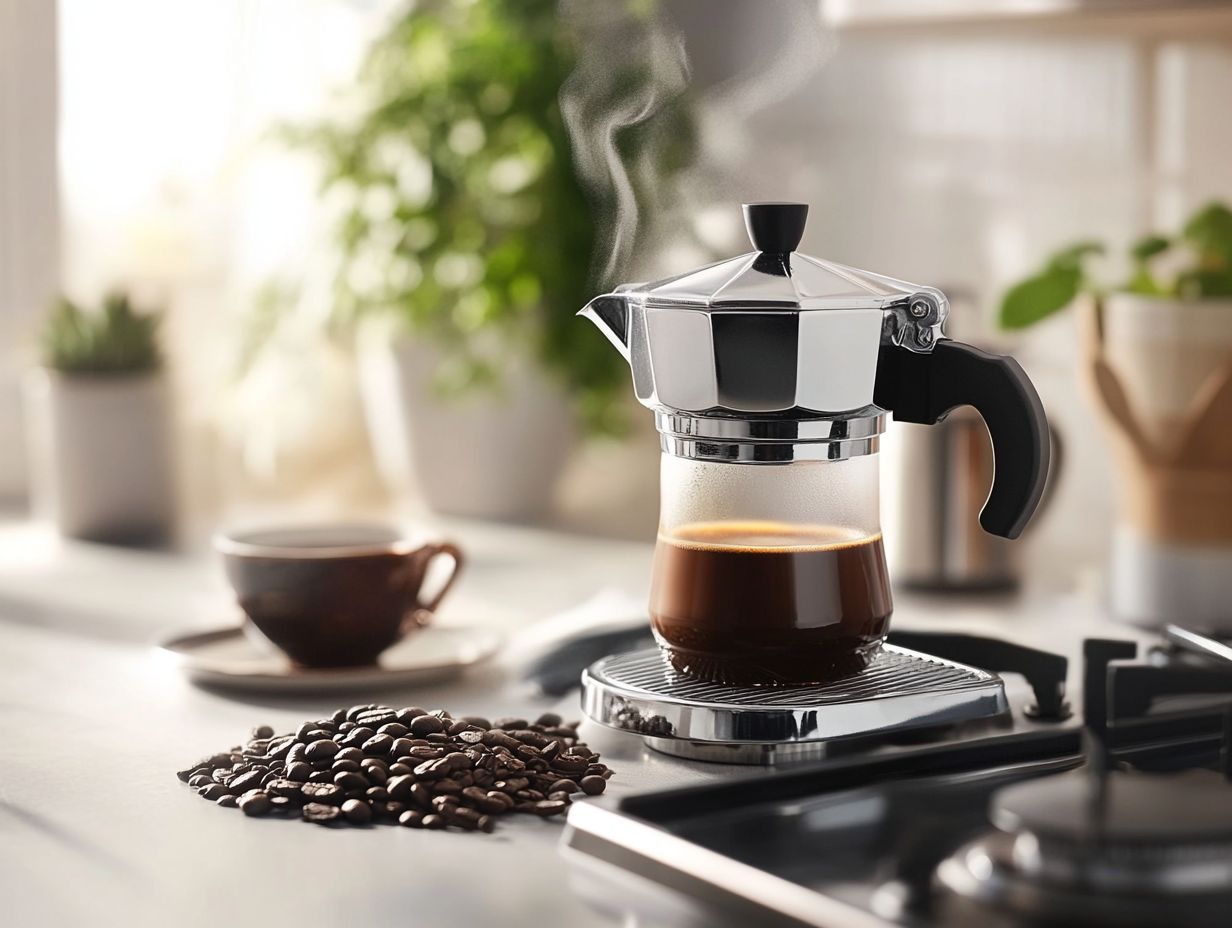
Ready to brew amazing coffee with your stovetop espresso maker? Let s gather the essentials!
First, high-quality coffee beans are crucial, as they serve as the foundation of your brew. A reliable grinder is also a must to achieve the perfect grind size typically a medium or medium-fine grind, which is ideal for stovetop brewing.
Choosing filtered water ensures a clean taste, and of course, you ll need the stovetop espresso maker itself, whether it’s a moka pot, percolator, or another type.
1. Coffee Beans
Choosing the right coffee beans is essential for crafting that perfect cup of coffee, especially when it comes to stovetop espresso makers. You might find that dark roast espresso blends or coffees from Central and South America are often the go-to options, celebrated for their rich and inviting flavors. Brands like Illy and Lavazza offer excellent options for high-quality pre-ground coffee.
Venturing into different varieties can truly enhance your coffee experience. For example, beans sourced from Ethiopia often deliver bright, fruity notes. This creates a delightful contrast with the deeper profiles found in Sumatran or Brazilian coffees. Try different coffee recipes. You might discover new flavors you love.
Freshness is crucial for flavor. Older beans can lose their aromatic qualities, diminishing the overall experience. Storing your beans in an airtight container, away from light and moisture, is crucial for preserving those intricate flavor nuances. This way, you’ll ensure a truly satisfying brew every single time, whether you’re making a caff macchiato or a simple hot coffee.
2. Grinder
A quality grinder is crucial for achieving the perfect coffee grind, as the size of the grind directly influences extraction and flavor. For stovetop espresso makers, you’ll typically want to aim for a medium to medium-fine grind.
Using the right grinder allows you to unlock the full potential of your beans, enhancing your coffee experience. There are two primary types of grinders to consider: blade grinders and burr grinders. Burr grinders are generally preferred for their consistency, making them ideal for achieving a medium-fine grind suitable for stovetop espresso makers.
Blade grinders chop the beans unevenly, which can lead to inconsistent extraction. In contrast, burr grinders crush the beans to a precise size, ensuring uniformity. This uniformity is particularly important when dealing with coffee grinds for stovetop espresso makers.
This consistency is essential because the grind size significantly affects the brewing process. It determines how quickly water extracts the flavors from the grounds. By selecting the appropriate grinder and grind size, you not only elevate your brewing experience but also influence the richness and complexity of your final cup of coffee. Whether you prefer a medium grind for a French press or a medium-fine grind for a moka pot, the right grinder makes all the difference.
3. Stovetop Espresso Maker
Brands like Bialetti, Frabosk, and other Italian manufacturers offer a variety of aluminum pots and stainless steel options to suit your coffee brewing needs. Make sure to choose a model with a reliable safety valve for added peace of mind.
The stovetop espresso maker is your essential ally in the art of brewing coffee. It presents a variety of designs, from the iconic moka pots to the sleek modern espresso machines, each boasting its own unique features and benefits. Embrace the rich heritage of the Italian coffee tradition with these versatile brewers.
These versatile machines cater to your specific tastes. You re drawn to the classic charm of the Bialetti Moka Express, celebrated for its retro aesthetic and straightforward approach. Or you may be captivated by the elegant lines of the Alessi Moka Pot, where art meets functionality. Companies like the Bialetti company and Frabosk have been leaders in this field, offering quality and innovation in their designs.
On the flip side, brands like Cuisinox and ROK prioritize usability, with innovative designs that enhance the user experience. This allows even novice brewers to effortlessly craft rich and flavorful coffee.
With such a wide array of options at your fingertips, you can indulge in the perfect cup at home. Whether you crave the authentic essence of traditional Italian coffee or the modern flair of contemporary brewing techniques, the perfect brew awaits.
Why Water Quality Matters in Brewing Coffee
Using filtered water is essential for your stovetop espresso maker, as it guarantees that the coffee’s flavor remains pristine and free from impurities. The water chamber in your espresso maker should always be filled with the highest quality water to ensure a superior brew.
The quality of the water you use can profoundly influence not just the aroma but also the overall taste of your coffee. Various minerals and contaminants present in tap water can introduce undesirable flavors that will ruin your coffee s taste, distracting from the intricate profiles of your coffee beans.
For example, hard water, which is rich in calcium and magnesium, might intensify bitterness. Water that’s overly chlorinated could leave an unpleasant metallic aftertaste.
Coffee enthusiasts should aim for water with ideal mineral levels ideally maintaining a pH level between 6.5 and 7.5. You might consider using bottled spring water or specialized coffee brewing water for optimal flavor. Referring to various brew guides can help you navigate the complexities of water quality and its impact on your coffee tastes.
Test your tap water regularly to identify any elements that could affect your brew.
Step-by-Step Guide to Brewing Coffee with a Stovetop Espresso Maker
Get ready to master each step from grinding the beans to pouring the perfect cup! Follow these detailed step-by-step instructions to ensure each cup is perfect.
Brewing coffee with a stovetop espresso maker transforms your morning ritual into a rewarding experience. By following these meticulous step-by-step instructions, you can achieve a perfect cup each time.
This guide will take you through every stage, from gathering your essential ingredients to the final pour. Start by gathering your essential ingredients and equipment: freshly ground coffee, filtered water, and your trusty stovetop espresso maker. Paying close attention to every detail of the brewing process is crucial, as it elevates the flavors and aromas of your coffee, allowing you to savor every delightful sip.
1. Grind the Coffee Beans
Begin your journey by grinding the coffee beans to a medium consistency, the gold standard for brewing with a stovetop espresso maker. This ensures a beautifully balanced extraction of flavors.
The grind size is pivotal in unlocking the rich and complex profiles of coffee, as it directly affects how swiftly water extracts the oils and essences from the beans. For achieving that perfect consistency, consider investing in a burr grinder, a grinder that provides evenly ground coffee for the best flavor; unlike its blade grinder counterparts that tend to create an uneven texture.
As a true coffee connoisseur, you should also appreciate the significance of using freshly roasted beans. They retain their flavor and aroma far better than pre-ground options. Grinding just before brewing is ideal, preserving the coffee’s exquisite qualities and allowing you to savor a vibrant, invigorating cup that truly showcases its unique character.
For the best results, consider trying a Dark Roast Espresso Blend or exploring the profiles of Central American coffees and South American coffees.
2. Add Water to the Stovetop Espresso Maker
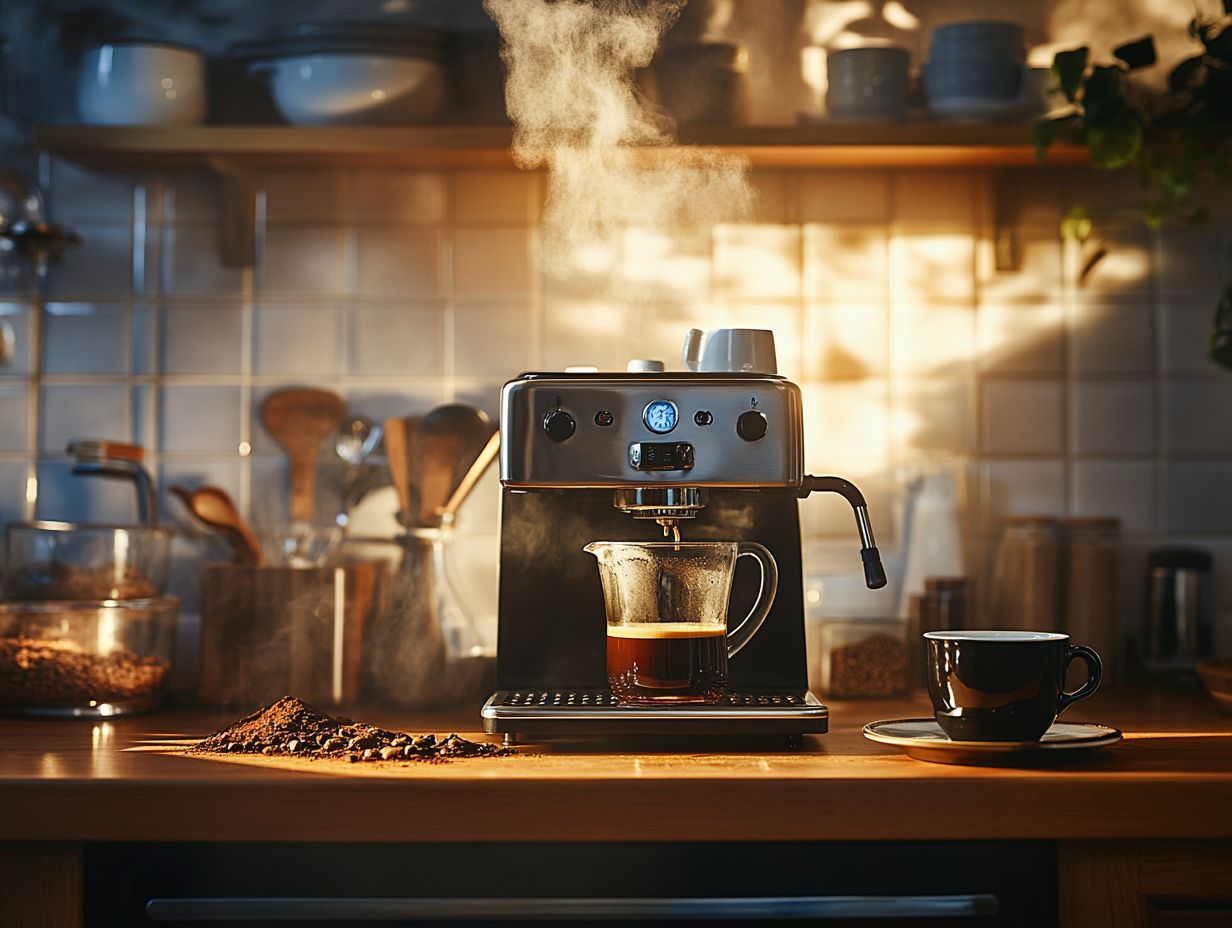
Next, fill the lower chamber of your stovetop espresso maker with filtered water, being careful not to exceed the safety valve. This step is crucial for safe brewing.
That specific water level matters; going beyond it can create pressure issues that compromise the quality of your espresso. Opting for filtered water instead of tap water can significantly elevate the taste, as it removes unwanted minerals and chemicals, allowing the true essence of your coffee to shine.
To maximize flavor extraction during brewing, pay attention to the grind size of your coffee beans; a medium-fine grind will deliver the best results. It’s also essential to maintain the proper brewing temperature, so avoid boiling the water before you start brewing to achieve that well-balanced cup you crave. Brands like Illy offer excellent blends that can enhance your experience.
3. Add the Ground Coffee to the Filter
Once you ve added the water, it s time to place the ground coffee into the filter basket. Make sure to distribute it evenly. This step is essential for ensuring uniform extraction during the brewing process.
Proper distribution of the coffee grounds is not just a minor detail. It plays a significant role in flavor extraction and the overall performance of your brew. If you pack the grounds too tightly, you risk creating channeling. This occurs when the water flows unevenly through the coffee, leading to an unbalanced and often bitter taste.
To achieve the best results, gently shake or tap the filter basket after adding the coffee. This allows the grounds to settle naturally.
Using a specific type of coffee grinder to achieve a consistent grind size is also advantageous. It can promote a better flow rate and even extraction. Remember, a light touch is crucial; your aim is to create a balanced bed of coffee that maximizes flavor extraction.
4. Assemble the Stovetop Espresso Maker
After adding the coffee grounds, take a moment to carefully assemble your stovetop espresso maker. Screw the upper chamber onto the lower chamber to ensure a secure fit. This is essential to prevent any leaks during the brewing process.
Be patient during this step. Rushing can lead to misalignment that negatively impacts your brew. Align the grooves properly to ensure an even connection between the two chambers. Also, resist the urge to over-tighten. Doing so can damage the threads and create a risk of breakage or leaks in future uses.
To guarantee a proper seal, inspect the rubber gasket. It should be intact and seated correctly within the upper chamber. Regularly cleaning and maintaining this part will significantly enhance its longevity. This provides a reliable barrier against pressure loss, crucial for achieving that rich, concentrated espresso flavor you re aiming for.
5. Place the Stovetop Espresso Maker on the Stove
Position your assembled stovetop espresso maker on your chosen heat source, whether it s a gas stove or something else. Ensure it is stable and centered for even heating throughout the brewing process.
Selecting the right heat source is vital for achieving that perfect brew. Different options provide varying levels of intensity. For instance, gas stoves allow for quick adjustments, enabling you to fine-tune the flame based on your desired coffee strength. Conversely, electric stoves, though slower to heat, offer a more consistent temperature.
Pay close attention to the flame. If it s too high, you ll end up with scorched grounds. If it s too low, it could lead to an under-extracted cup of disappointment. Always prioritize safety by keeping flammable items far from the cooking area and remaining attentive during the brewing process. This ensures a delightful and risk-free experience.
6. Heat and Brew the Coffee
Get ready as the stovetop espresso maker warms up. You ll see the water bubbling with anticipation, and soon enough, steam pressure will push that hot water through the coffee grounds. This delivers a rich brew crowned with a delightful crema.
Understanding this brewing process is essential for any coffee enthusiast. The secret to achieving the perfect cup lies in the brewing time, which usually falls between three to five minutes. Keep a watchful eye on the pot; once you hear that telltale gurgle, it s a clear sign that your coffee is almost ready.
If you re eager to personalize your brew, experiment with grind size and the coffee-to-water ratio to explore a world of flavor profiles. A finer grind will amp up the flavor, while a coarser grind might give you a gentler taste. Tweaking the brewing time just a bit can enhance or soften the coffee’s boldness, allowing you to tailor each cup to your unique preferences. This makes every sip a distinct experience.
7. Serve and Enjoy Your Coffee
Once you ve completed the brewing process, take a moment to pour the freshly brewed coffee into your favorite cup. This is your opportunity to savor the rich flavors and aromas that you ve carefully crafted.
To elevate your coffee experience, aim to serve it at the ideal temperature of around 130 F to 160 F. This range allows the flavors to unfold beautifully without overpowering your palate. If you prefer a milder touch, consider adding a splash of milk or indulging in a caff macchiato for a delightful contrast.
For an even more luxurious experience, whip your milk until it s creamy and airy to create a velvety texture. You can also sprinkle a hint of cocoa powder or cinnamon on top for an added layer of depth.
Pairing your coffee with a buttery croissant or a slice of rich chocolate cake can enhance its bold characteristics, transforming your moment into something truly indulgent. If you enjoy a cappuccino, perfecting your milk foaming technique is essential to recreate that caf experience at home.
Tips for Using a Stovetop Espresso Maker
From selecting the right beans to perfecting your brewing technique, these tips cover all aspects of achieving the ideal espresso.
Using a stovetop espresso maker, like those from the renowned Bialetti company, can transform your coffee experience into something truly extraordinary. Get ready to transform your coffee-making into an exciting culinary adventure with a few key tips and tricks.
Start by ensuring that your equipment is spotless. Use fresh, high-quality coffee beans from brands like Illy or a Dark Roast Espresso Blend that align with your personal taste. Understanding the subtleties of the brewing process, such as water temperature and grind size, will profoundly influence the quality of your final brew. Grind size refers to how fine or coarse the coffee grounds are, affecting the brew’s flavor.
This understanding allows you to savor the rich, robust flavors that stovetop espresso is celebrated for, whether you prefer Central American coffees or South American coffees, turning each cup into a moment of pure enjoyment.
Frequently Asked Questions
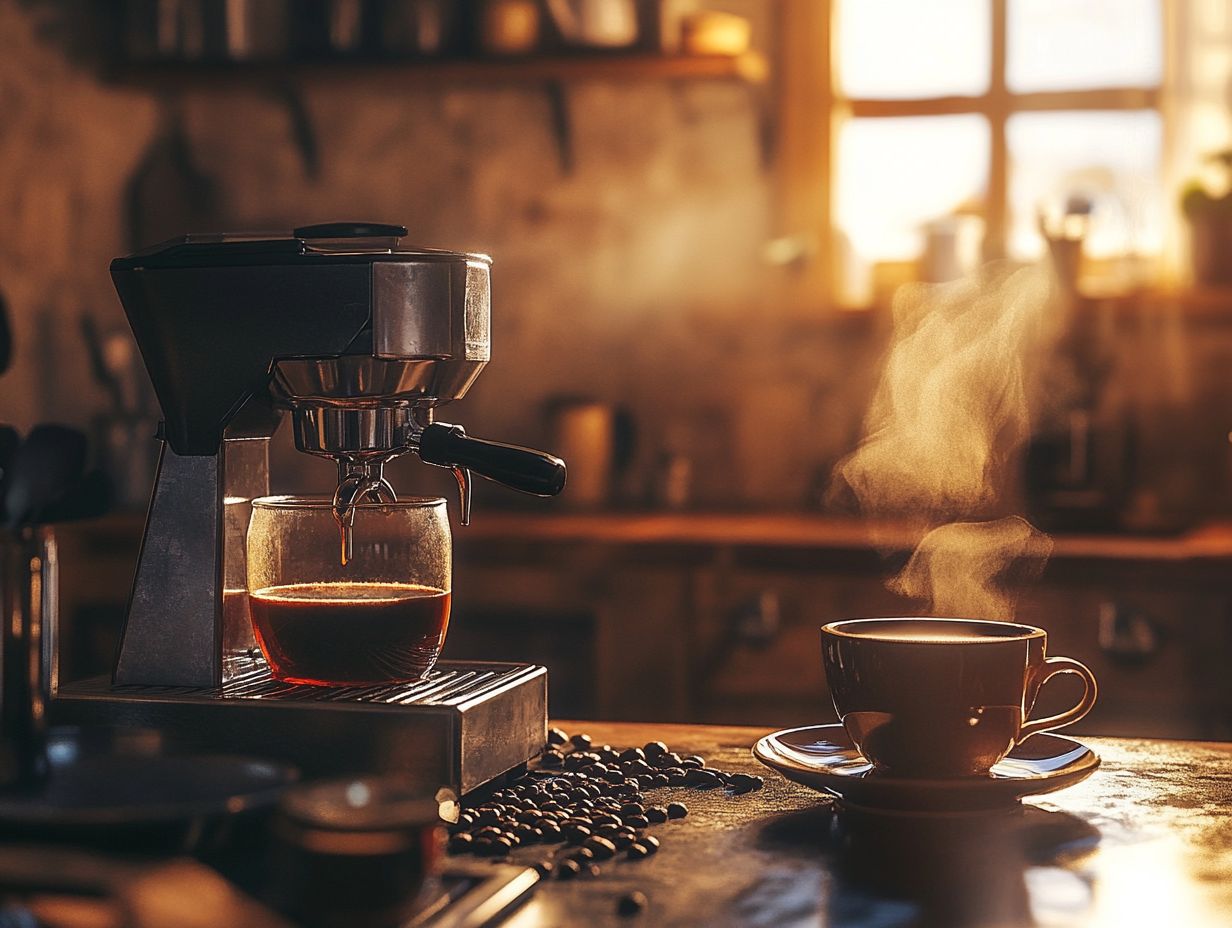
Here are some common questions about using a stovetop espresso maker.
How do I use a stovetop espresso maker to brew coffee?
Companies like Frabosk also produce high-quality stovetop espresso makers.
To use a stovetop espresso maker, fill the bottom chamber with water and add ground coffee to the filter basket. Then, screw on the top chamber and place the maker on the stove over medium heat. Once the water boils, it will pass through the coffee grounds and collect in the top chamber as espresso.
What kind of coffee should I use in a stovetop espresso maker?
Consider trying dark roast blends from Italy for an authentic taste.
For the best results, use a fine grind of coffee specifically labeled as espresso or Italian roast. This type of coffee is more finely ground and is specifically designed for use in stovetop espresso makers.
How much coffee should I use in a stovetop espresso maker?
If you prefer a stronger brew, consider using a bit more coffee, especially if you’re making a cappuccino.
The amount of coffee to use depends on the size of your stovetop espresso maker. As a general rule, use one tablespoon of coffee per cup of water. So, for a 6-cup espresso maker, use 6 tablespoons of coffee.
Do I need to preheat the stovetop espresso maker before brewing coffee?
The Bialetti company, founded in Italy, has revolutionized the way we brew espresso.
No, you do not need to preheat the stovetop espresso maker. The water will heat up quickly as it is placed on the stove and will begin to brew the coffee immediately.
How long does it take to brew coffee with a stovetop espresso maker?
The entire brewing process usually takes about 5-10 minutes, depending on the heat of your stove and the amount of coffee being brewed. It is important to keep an eye on the espresso maker to prevent it from boiling over or burning the coffee.
Can I use a stovetop espresso maker on an electric stove?
Yes, stovetop espresso makers can be used on both gas and electric stoves. However, be sure to use a medium heat setting on an electric stove to prevent the handle from melting or getting damaged.
Ready to brew your perfect cup? Grab your stovetop espresso maker and start your coffee journey today!

